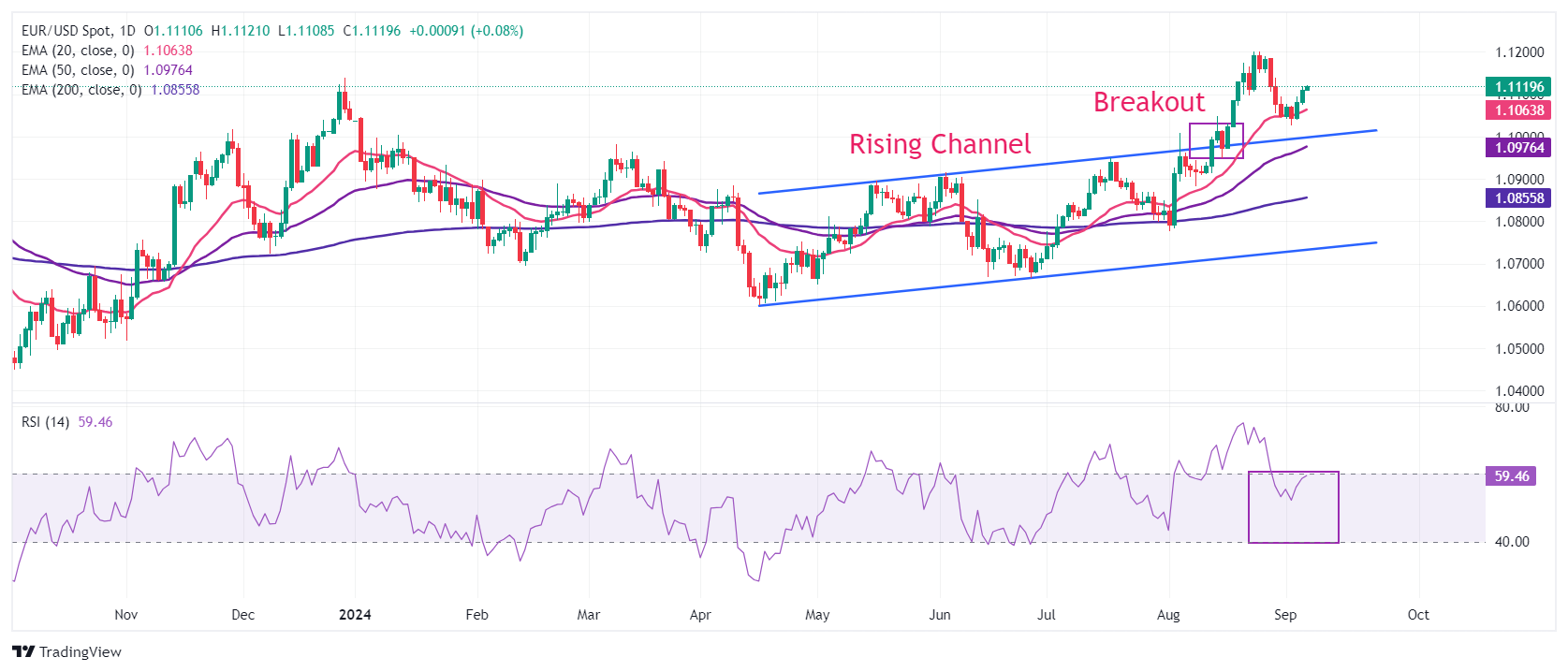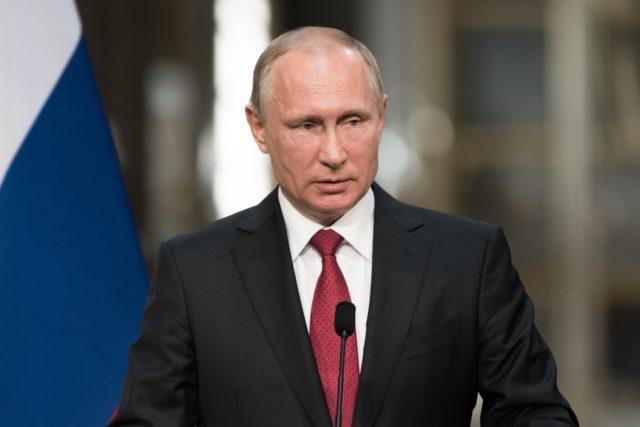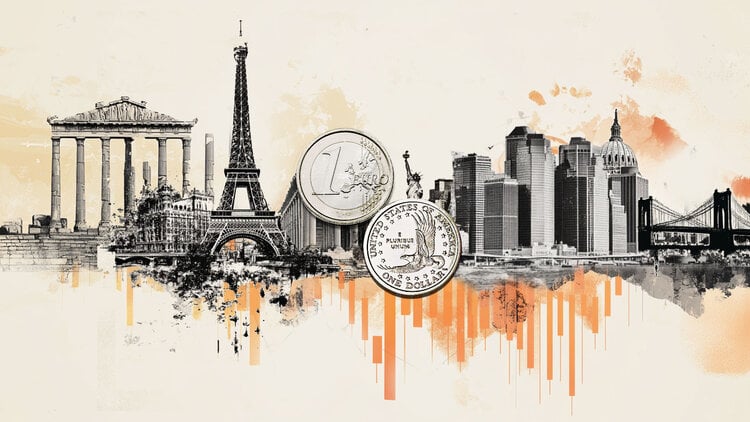- EUR/USD extends its rise above 1.1100 as signs of slowing US labor demand weigh on the US Dollar.
- Investors are awaiting US NFP data for August as markets wonder whether the July report was just a blip or the start of a more serious deterioration.
- The ECB is expected to cut interest rates twice more this year.
EUR/USD extends its winning streak for the third consecutive session on Friday, trading near a fresh weekly high of 1.1120. Decent gains in the pair are driven by sheer weakness in the US Dollar (USD). The US Dollar Index (DXY), which measures the value of the Greenback against six major currencies, falls further below the crucial support of 101.00.
The US dollar’s appeal has weakened after the US JOLTS job openings data for July and ADP employment data for August, released earlier this week, deepened fears of a deterioration in labour market conditions. New job openings and payroll additions in the private sector stood at 7.67 million and 99,000, respectively, the lowest in more than three and a half years.
US ISM Services Purchasing Managers’ Index (PMI) data for August came in better than projected but failed to cushion the US Dollar.
Signs of slowing labor demand boosted market expectations that the Federal Reserve (Fed) could start cutting interest rates aggressively. According to the CME’s FedWatch tool, the chance that the Fed will start cutting interest rates by 50 basis points (bps) to 4.75%-5.00% has risen to 41% from 34% a week ago.
For further clues on the path of interest rates, investors will focus on the US Non-Farm Payrolls (NFP) data for August, due at 12:30 GMT. The official employment data is expected to show that US employers hired 160,000 new employees, up from July’s reading of 114,000. The unemployment rate is estimated to have declined to 4.2% from the previous release of 4.3%.
Investors will also be focused on U.S. Average Hourly Earnings data, a key measure of wage growth that influences consumer spending. Earnings are expected to have accelerated to 3.7% from 3.6% in July on a year-over-year basis. The wage growth measure is forecast to have risen 0.3% on the month, faster than the previous increase of 0.2%.
Daily Market Wrap: EUR/USD Rises as US Dollar Weakens
- EUR/USD rises on sheer US Dollar weakness ahead of US NFP data. On its own, the Euro (ECB) is putting in a mixed performance against its major rivals as traders are uncertain about the European Central Bank (ECB) interest rate path for the remainder of the year.
- The ECB is widely expected to cut interest rates again at the September meeting. The central bank began the process of easing policy in June but kept its key interest rates unchanged in July. For the final quarter of this year, traders are divided on whether the ECB will cut at the November or December meeting, or both.
- Bank of America (BofA) economists said in their latest Eurozone outlook: “We still see more cuts in 2025/26 than the market is pricing in, with a return to a 2% deposit rate by 3Q25 (at the latest) and 1.5% in 2026.” BofA analysts said the recovery in the Eurozone remains fragile and is likely to be shallow, pressured by a number of economic factors, including slow growth in China, as well as political factors.
- More evidence of the economic struggle came from the eurozone’s two largest economies. Industrial output in Germany fell 2.4% in July, much more than the 0.3% drop expected by economists. In France, industrial output fell 0.5%.
- According to a Reuters poll conducted between August 30 and September 5, 85% of economists expect the ECB to cut interest rates next week and again at its December meeting.
- Meanwhile, most ECB officials appear comfortable with market speculation about interest rate cuts as they remain concerned about rising risks to Eurozone economic growth. ECB Executive Board member Piero Cipollone said in an interview with a French newspaper this week that “there is a real risk that [la postura del BCE] become too restrictive.”
Technical Analysis: EUR/USD holds gains above 1.1100
EUR/USD remains stable above the round level of 1.1100. The near-term outlook for the pair remains firm as it manages to gain a foothold near the 20-day exponential moving average (EMA) around 1.1055.
The longer-term outlook is also bullish as the 50-day and 200-day EMAs at 1.0970 and 1.0865, respectively, are sloping upwards. Moreover, the pair is holding the breakout of the ascending channel on a daily time frame.
The 14-day Relative Strength Index (RSI) has fallen below 60.00 after turning overbought near 75.00.
On the upside, the recent high of 1.1200 and the July 2023 high of 1.1275 will be the next target for Euro bulls. Meanwhile, the downside is expected to remain cushioned near the psychological support of 1.1000.
Euro FAQs
The Euro is the currency of the 20 European Union countries that belong to the Eurozone. It is the second most traded currency in the world, behind the US Dollar. In 2022, it accounted for 31% of all foreign exchange transactions, with an average daily volume of over $2.2 trillion per day. EUR/USD is the most traded currency pair in the world, accounting for an estimated 30% of all transactions, followed by EUR/JPY (4%), EUR/GBP (3%) and EUR/AUD (2%).
The European Central Bank (ECB), based in Frankfurt, Germany, is the reserve bank of the Eurozone. The ECB sets interest rates and manages monetary policy. The ECB’s main mandate is to maintain price stability, which means controlling inflation or stimulating growth. Its main instrument is to raise or lower interest rates. Relatively high interest rates – or the expectation of higher rates – generally benefit the Euro and vice versa. The Governing Council of the ECB takes monetary policy decisions at meetings held eight times a year. Decisions are taken by the heads of the national banks of the Eurozone and six permanent members, including ECB President Christine Lagarde.
Eurozone inflation data, as measured by the Harmonized Index of Consumer Prices (HICP), is an important econometric data point for the euro. If inflation rises more than expected, especially if it exceeds the ECB’s 2% target, the ECB is forced to raise interest rates to bring inflation back under control. Relatively high interest rates compared to their peers usually benefit the euro, as it makes the region more attractive as a place for global investors to park their money.
Data releases measure the health of the economy and can influence the Euro. Indicators such as GDP, manufacturing and services PMIs, employment and consumer sentiment surveys can influence the direction of the single currency. A strong economy is good for the Euro. Not only does it attract more foreign investment, but it can encourage the ECB to raise interest rates, which will directly strengthen the Euro. Conversely, if economic data is weak, the Euro is likely to fall. Economic data from the four largest Eurozone economies (Germany, France, Italy and Spain) are especially significant, as they account for 75% of the Eurozone economy.
Another important output for the euro is the trade balance. This indicator measures the difference between what a country earns from its exports and what it spends on imports during a given period. If a country produces highly sought-after export products, its currency will appreciate due to the additional demand created by foreign buyers who wish to purchase these goods. Therefore, a positive net trade balance strengthens a currency and vice versa for a negative balance.
Source: Fx Street
I am Joshua Winder, a senior-level journalist and editor at World Stock Market. I specialize in covering news related to the stock market and economic trends. With more than 8 years of experience in this field, I have become an expert in financial reporting.








